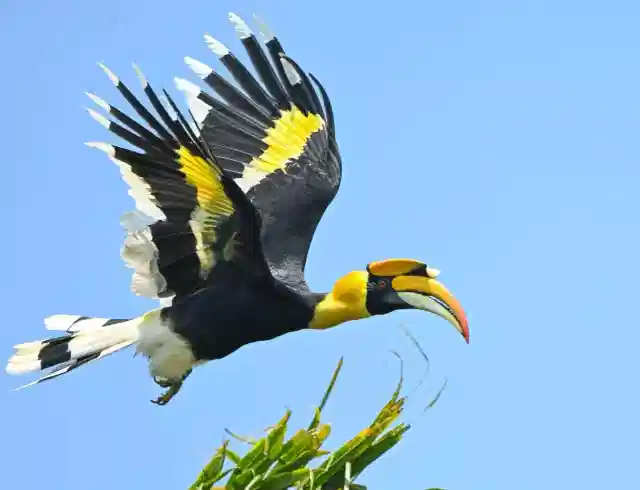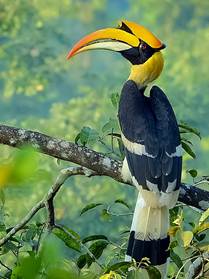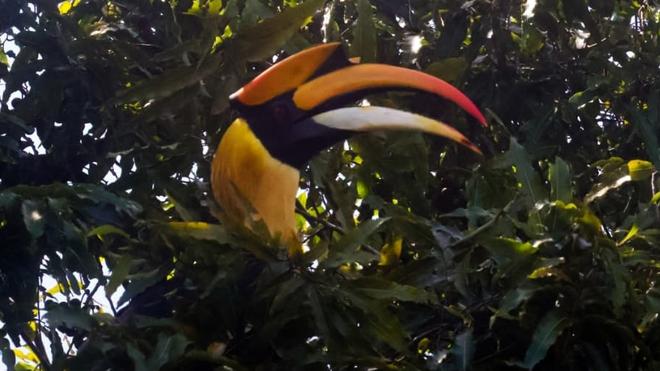The Lost Monarch Of Malabar Coast: A Great Hornbill Strays Onto Kochi Shores
A Great Hornbill, Kerala’s state bird and a rare dweller of misty Western Ghats forests, has strayed to the coconut palms of Kochi. Its majestic arrival stuns birders, but its absence leaves a family waiting.

A truly amazing and unique spectacle is currently unfolding on the Malabar coast. A Great Hornbill, an endangered species and one of the most majestic birds ever to take wing, has strayed away from its natural habitat of deep forests high up in the Western Ghats. It is now solemnly roosting amongst coconut palms, just a few minutes flying time north of the LNG terminal at Vypeen, Kochi.
This Great Hornbill, a male, was first spotted in Kodungalloor a fortnight ago, not far from the legendary Bhagavathi Temple near the mouth of the Periyar River, associated with Adi Shankaracharya. A week later, it was seen at Cherai Beach on the south side of the Periyar. On 12 August, it decided to grace Kochi with its stunning presence.
This is tragic because Hornbills mate for life, and the male is the main forager for the family. The situation is even worse during the monsoon because chicks hatch in May. Somewhere in the Western Ghats, Hornbill chicks are still young, and a mother is being forced to do double duty in the absence of the father.

The day had begun so quietly. This writer was at his desk, contemplating an article on capital spending on infrastructure in the states of the union, sipping a fine green tea, when the phone rang.
It was Jayadev Menon, one of the senior-most birders in Kerala. “You are not going to believe this,” he shouted excitedly, “but a Great Hornbill was spotted an hour ago in Vypeen!”
Utter disbelief. “No way! A Hornbill on the coast? No way!”“Way!” shouted Jayadev. “Move it! Move it!”
The sighting spot was a dense thicket of old trees behind a mosque. Birders began to congregate in silent greetings, peering into the dark canopy for a sight of their prize. A collective gasp rose. There it was, atop a Jackfruit tree, bathed in sunshine. OMG.
The Great Hornbill’s large, bright-yellow casque, a characteristic enlargement of the skull into a cap-like feature, glinted in the daylight. It was faced away, preening. Then it turned its head to present its long, broad, yellowish-orange, down-curved beak in an imposing side profile. Bliss.
It was a surreal sight. The state bird of both Kerala and Arunachal Pradesh, a resident of misty hills and mountainsides, was on the coast, flanked by a pair of Talipot Palms. The frenzied clicks of expensive cameras rose in unison, while underprivileged ones like this writer had to make do with their cell phones.


When everyone had had their fill, it was time for a round of reactions. For Sharath TS, who managed an epic snap of the Great Hornbill taking off from a Coconut tree, it was a mixture of euphoria and worry.
On one hand, he was still reeling from the moment. On the other, he wondered how the male would make it back to his nest. Perhaps the Forest Department would dart it, drug it, and relocate it back to the hills east of Thrissur, its most probable home, said Xavier, another seasoned birder. May it happen soon.
Jayadev had a practical angle. Every year, thousands of avid birders spend thousands of rupees to make two- or three-day trips into the Western Ghats in search of Hornbills during the breeding season. These are rigorous expeditions which often end in disappointment, with the only reward being a dozen leech bites.
Young Sandeep had no words. He just kept shaking his head, speechless, struck by the improbable sight. Just then, a gaggle of excited schoolgirls scurried into the thicket. Word had spread that a Vezhambal (Malayalam for Hornbill) had been spotted in their area. “Where? Where?” they asked animatedly, and the party scattered for a sighting.
Afterwards, there was only the quiet ride home, subdued, still struck by incredulity. The car stereo matched the mood perfectly by playing the Pink Floyd classic Comfortably Numb. Apt. And echoed by a prayer, that this Great Hornbill be reunited with his family soon, because no one deserves to pine for their loved ones.
Recent reports indicate an unusual and significant sighting of a Great Hornbill (Buceros bicornis), the state bird of Kerala, on the coastal shores near Kochi. This is a rare phenomenon, as these majestic birds, also known as ‘Malamuzhakki Vezhambal’, are typically found in the forested high ranges of the Western Ghats.
The Sighting and Its Significance
Yes, there was a recent rare sighting of the Great Hornbill (Buceros bicornis), also known as the Great Indian Hornbill or Malamuzhakki Vezhambal, Kerala’s state bird according to PWOnlyIAS, in a coastal belt of Kakkampara, near Ezhimala, Kannur district, Kerala. This is considered a rare and ecologically significant event because Great Hornbills are primarily forest dwellers and are very rarely seen in coastal areas. The sighting has generated much interest among birdwatchers and conservationists, highlighting the need for biodiversity conservation in coastal ecosystems and local forested hill zones.
Previously, the Great Hornbill was typically found in evergreen and moist deciduous forests, mainly within the Western Ghats and Northeast India, in locations such as Silent Valley, Nelliampathy, Aralam, Athirappilly, and Parambikulam.
The sighting of the Great Hornbill in an unusual habitat suggests potential shifts in habitat preferences due to factors like climate change or forest degradation, or it may indicate an underexplored biodiversity hotspot in the Ezhimala-Ramanthali belt.
The Great Hornbill is listed as Vulnerable on the IUCN Red List and is protected under Schedule I of the Indian Wildlife (Protection) Act, 1972. Protecting this species is important because it plays a vital role as a seed disperser and ecological indicator.
The Great Hornbill, Kerala’s State Bird and typically a forest-dwelling species, was recently sighted in the coastal region of Kakkampara near Ezhimala in Kannur district — an unusual habitat for the species, raising ecological and conservation interest.Species Overview:Common Name: Great Hornbill (MalamuzhakkiVezhambal)Scientific Name:BucerosbicornisConservation Status:IUCN: EndangeredIndian Wildlife Protection Act, 1972: Schedule I species (highest protection)Typical Habitat and Distribution:Found in evergreen and moist deciduous forests across the Western Ghats and parts of Northeast India.Common in forest areas such as Silent Valley, Nelliampathy, Aralam, Athirappilly, and Parambikulam.Very rarely seen in coastal areas, making this sighting ecologically significant.Ecological Significance:Great Hornbills are indicator species, reflecting the health of forest ecosystems.Their diet of fruits plays a crucial role in seed dispersal and forest regeneration.
Ecological Context
- Species: Buceros bicornis (Great Hornbill), locally known as Malamuzhakki Vezhambal.
- Conservation Status:
- IUCN: Endangered
- Indian Wildlife Protection Act, 1972: Schedule I species (maximum protection)
- Typical Habitat: Evergreen and moist deciduous forests of the Western Ghats.
- Notable ranges: Silent Valley, Parambikulam, Athirappilly, Nelliyampathy, Aralam.

Relevance : GS 3(Environment and ecology)
The Sighting: Key Facts
- Location: Kakkampara near Ezhimala, Kannur, Kerala – a coastal belt.
- Date: First spotted on May 24, 2025.
- Duration of Stay: The bird remained in the area for about two weeks.
- Initial Sighting: Perched on a fig-laden Ficus exasperata tree.
- Movement: Foraged in the area, flew occasionally to nearby habitats including the Ezhimala Naval Academy campus.
- Observers: Birdwatchers Manoj Karingamathil, P. Jameela, and forestry student Abhinav Jeevan.
Significance of the Sighting
- Geographical Rarity:
- Great Hornbill sightings in coastal zones are highly unusual; primarily forest dwellers.
- No documented evidence exists of previous sightings this close to the sea in Kannur district.
- Ecological Indicator:
- Presence outside its traditionalrange may indicate:
- Shifting habitat preferences due to climate change or forest degradation.
- An underexplored biodiversity hotspot in the Ezhimala-Ramanthali belt.
- Presence outside its traditionalrange may indicate:
- Biodiversity Significance:
- Local governance (Ramanthali Grama Panchayat) hailed the sighting as proof of continued biodiversity richness despite human habitation.
- Reinforces importance of semi-urban fringe areas as ecological buffers.
Conservation & Policy Implications
| Indicator | Details |
| Conservation Priority | High (Endangered, Schedule I species) |
| Conservation Concern | Habitat shrinkage, forest fragmentation, poaching |
| Policy Call | Need for micro-level habitat protection in coastal areas |
| Research Need | Mapping of non-traditional sightings and coastal foraging corridors |
| Citizen Science Role | Accidental discovery via WhatsApp status, highlighting scope of public involvement in biodiversity tracking |
Broader Ecological Reflections
- Climate Link?: Possible range shifts due to habitat loss, climate stressors, or changing food availability.
- Seed Disperser Role: Hornbills play a crucial role in forest regeneration through dispersal of fig and fruit tree seeds.
- Conservation Gap: Coastal ecosystems often overlooked in hornbill conservation plans, despite potential seasonal or adaptive significance.
Way Forward
- Biodiversity Zonation: Integrate coastal hills like Ezhimala into eco-sensitive zone mapping.
- Species Monitoring: Use citizen science + academic research to build sighting databases.
- Community Engagement: Train local communities to identify and report rare wildlife sightings.
- Habitat Linkage: Restore coastal-forest ecological corridors for seasonal/occasional wildlife dispersal.
The Great Hornbill (Buceros bicornis) is typically found in tall, dense, old-growth forests, particularly in hilly regions. Its presence in an atypical habitat is notable because it suggests the species might be adapting to or utilizing areas outside its usual range. This could be due to habitat loss, food availability, or other environmental factors. Great Hornbills are known to inhabit areas like the Western Ghats, Northeast India, and the Himalayan foothills. They are also found in Southeast Asia and Sumatra. The species relies on tall trees with natural cavities for nesting and requires large forest stretches.
Key points about the Great Hornbill and its habitat:
- Natural Habitat: They are primarily found in wet evergreen and mixed deciduous forests, often in hilly regions with old-growth trees.
- Nesting: Great Hornbills require tall trees with natural cavities for nesting.
- Seed Dispersal: They play a crucial ecological role as seed dispersers, particularly for fig trees, according to India Bird Watching.
- Threats: Habitat loss, deforestation, and hunting are major threats to the species.
- Adaptation: While typically found in forests, they may venture into more open areas to find food and may be adapting to modified habitats, such as coffee plantations.
- Conservation: Protecting their habitat and ensuring the availability of nesting trees are essential for their survival.
The Great Hornbill’s adaptability, or lack thereof, in different environments is a subject of ongoing research and conservation efforts. A study published in The Hindu suggests they can adapt to modified habitats, provided their key requirements for food and nesting are met.
In a rare and unprecedented sighting, an adult male Great Hornbill, Kerala’s State bird and a species usually confined to the forested high ranges of the Western Ghats, was spotted in the coastal belt of Kodungallur and Kaipamangalam, just 200 m from the beach.
Hornbill researcher Amitha Bachan K.H. and research scholar Aswin Krishna photographed the bird feeding on a large False Ashoka tree (Monoon longifolia), locally known as ‘Aranamaram.’
“This is the first such record from Kerala where the location is right at sea level, on an isolated tree on a sandy coastal beach,” said Dr. Bachan, founder of the Western Ghats Hornbill Foundation and member of the IUCN Hornbill Specialist Group. “Great Hornbills are usually associated with the forested high ranges, so seeing one on an isolated coastal tree is highly unusual.”
A similar report emerged from Kannur in July this year, near the Ezhimala Naval Academy campus. It was also sighted once in the coastal region of Thiruvananthapuram a decade ago. Both of the earlier reports were in lateritic hillock regions near the coast, where there are large vegetation tracts similar to small patches of forest. “But here, it was a sandy beach setting, which makes this instance unique,” Dr. Bachan noted.
The Great Hornbill, showing no fear of humans, was observed foraging among native fruiting trees near the residence of Sabira, staff member at MES Asmbi College, where the hornbill foundation’s Research Extension Centre operates. The researchers witnessed the bird’s distinctive feeding method – plucking fruits with the tip of its beak, tossing them into the air, and catching them in its mouth before swallowing.
Three possibilities
According to Dr. Bachan, the sighting could point to three possibilities: “First, it may be a sign of successful conservation in our core hornbill habitats like Vazhachal and Nelliyampathi, leading to increased non-nesting movements. Second, it could indicate behavioural changes, with birds becoming more tolerant of humans. Third, changing climate patterns — early rains, persistent mist, and lush vegetation — may also be influencing these movements. Each of these factors needs deeper study.”
The nearest Great Hornbill populations are 35–50 km away in the Vazhachal, Vellikulangara–Anapantham, Peechi, and Nelliyampathi forest ranges. International records show that the species can travel over 100–200 km during non-nesting season.
Possible Reasons for the Straying
Experts and researchers are considering several possibilities for this unusual movement:

Successful hornbill conservation efforts are indeed showing positive results in core habitats, with community-based programs playing a vital role in protecting these birds and their ecosystems. These efforts, often involving local communities, are helping to reverse the decline of hornbill populations by addressing threats like habitat loss and hunting.
Here’s a more detailed look:
- Community-based conservation:Programs like the Hornbill Nest Adoption Program (HNAP) in Arunachal Pradesh, where local communities actively protect hornbill nests, demonstrate the effectiveness of community involvement.
- Shifting from hunters to protectors:In some regions, former hunters have become dedicated nest protectors, highlighting a positive change in attitudes and behaviors towards hornbills.
- Addressing threats:These conservation efforts are directly tackling threats like habitat loss, fragmentation, and hunting, which are major factors in hornbill decline.
- Positive impact on forest health:Hornbills are indicators of forest health, and their protection contributes to the overall well-being of the ecosystem, according to The Hindu.
- Artificial nesting sites:The use of artificial nesting sites, like those used for Great Hornbills, provides safe breeding grounds and improves breeding success, according to Ontosight.
- Community awareness:Education and awareness campaigns are crucial for fostering community support and encouraging sustainable practices that benefit hornbills and their habitats.
- Monitoring with technology:Drones and other technologies are being used to monitor hornbill habitats and track their movements, aiding in more effective conservation strategies.
- Examples of success:The HNAP in Pakke Tiger Reserve and similar initiatives in Thailand show that community-based conservation can be highly successful in protecting hornbills and their habitats.
Yes, hornbills, like some other wildlife, may be showing increased tolerance to human presence. This could be due to a variety of factors, including habituation to human activity, particularly in areas with consistent human presence like tourist destinations or urban environments. However, it’s important to note that this increased tolerance doesn’t necessarily mean they are unaffected by human presence, and some behavioral changes may still occur.
Here’s a more detailed look:
- Habituation:Animals can become accustomed to human presence over time, especially if there’s no perceived threat. This is especially true in areas where humans are a regular part of the environment, like tourist spots or even urban areas.
- Reduced Flight Initiation Distance:One indicator of increased tolerance is a shorter “flight initiation distance,” meaning they allow humans to approach more closely before taking flight.
- Shifts in Behavior:While some hornbills may tolerate closer proximity, their behavior might still be influenced by human presence. For example, they might adjust their foraging patterns or exhibit changes in their social interactions.
- Environmental Factors:Factors like weather, habitat type, and the presence of other animals can also play a role in how hornbills respond to human activity.
- Individual Variation:It’s also important to remember that individual hornbills may have different levels of tolerance, and some may still be wary of humans.